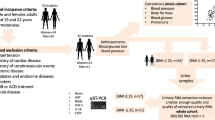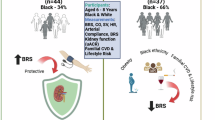Abstract
Background:
Metabolic abnormalities in obesity can overstimulate the renal epithelial sodium channel (ENaC) and subsequently lead to blood pressure (BP) elevation. Prostasin, a membrane-bound/secretive serine protease, is thought to activate ENaC via the proteolytic cleavage of the channel. Our specific aim was to explore whether there is a relationship between adiposity and urinary prostasin excretion at the population level.
Methods:
In 271 African-American adolescents, urinary prostasin concentrations were determined by enzyme-linked immunosorbent assay and normalized by urinary creatinine.
Results:
Urinary prostasin excretion increased in the overweight/obese group (n = 110, 38.2 ± 4.0 ng/mg) vs. the normal-weight group (n = 161, 20.7 ± 1.2 ng/mg, P = 0.03). Urinary prostasin excretion was significantly correlated with BMI percentiles (r = 0.14, P = 0.02), waist circumference (r = 0.13, P = 0.05), total body fat mass (r = 0.20, P < 0.01), and percentage body fat (r = 0.23, P < 0.01). Urinary prostasin excretion was also correlated with plasma aldosterone (r = 0.11, P = 0.05) and systolic BP (SBP; r = 0.15, P = 0.02), but the significances disappeared after adjustment of any of the adiposity variables.
Conclusion:
Our data for the first time suggest that adiposity plays a role in urinary prostasin excretion, and its associations with aldosterone and BP appear to be modulated by adiposity. Whether urinary prostasin excretion is a biomarker/mechanism underlying obesity-related hypertension deserves further investigations.
Similar content being viewed by others
Log in or create a free account to read this content
Gain free access to this article, as well as selected content from this journal and more on nature.com
or
References
Zhu H, Yan W, Ge D, et al. Relationships of cardiovascular phenotypes with healthy weight, at risk of overweight, and overweight in US youths. Pediatrics 2008; 121:115–22.
Sorof J, Daniels S . Obesity hypertension in children: a problem of epidemic proportions. Hypertension 2002;40:441–7.
Harshfield GA, Dong Y, Kapuku GK, Zhu H, Hanevold CD . Stress-induced sodium retention and hypertension: a review and hypothesis. Curr Hypertens Rep 2009;11:29–34.
Hall JE . The kidney, hypertension, and obesity. Hypertension 2003;41(3 Pt 2):625–33.
Gormley K, Dong Y, Sagnella GA . Regulation of the epithelial sodium channel by accessory proteins. Biochem J 2003;371(Pt 1):1–14.
Bubien JK . Epithelial Na+ channel (ENaC), hormones, and hypertension. J Biol Chem 2010;285:23527–31.
Saha C, Eckert GJ, Ambrosius WT, et al. Improvement in blood pressure with inhibition of the epithelial sodium channel in blacks with hypertension. Hypertension 2005;46:481–7.
Kitamura K, Tomita K . Regulation of renal sodium handling through the interaction between serine proteases and serine protease inhibitors. Clin Exp Nephrol 2010;14:405–10.
Koda A, Wakida N, Toriyama K, et al. Urinary prostasin in humans: relationships among prostasin, aldosterone and epithelial sodium channel activity. Hypertens Res 2009;32:276–81.
Olivieri O, Castagna A, Guarini P, et al. Urinary prostasin: a candidate marker of epithelial sodium channel activation in humans. Hypertension 2005;46:683–8.
Zhu H, Chao J, Guo D, et al. Urinary prostasin: a possible biomarker for renal pressure natriuresis in black adolescents. Pediatr Res 2009;65:443–6.
Zhu H, Guo D, Li K, et al. Prostasin: a possible candidate gene for human hypertension. Am J Hypertens 2008;21:1028–33.
Guzik TJ, Mangalat D, Korbut R . Adipocytokines - novel link between inflammation and vascular function? J Physiol Pharmacol 2006;57:505–28.
DiPetrillo K, Coutermarsh B, Soucy N, Hwa J, Gesek F . Tumor necrosis factor induces sodium retention in diabetic rats through sequential effects on distal tubule cells. Kidney Int 2004;65:1676–83.
Eisenhut M . Changes in ion transport in inflammatory disease. J Inflamm (Lond) 2006;3:5.
Lee DL, Sturgis LC, Labazi H, et al. Angiotensin II hypertension is attenuated in interleukin-6 knockout mice. Am J Physiol Heart Circ Physiol 2006;290:H935–40.
Satou R, Gonzalez-Villalobos RA, Miyata K, et al. Costimulation with angiotensin II and interleukin 6 augments angiotensinogen expression in cultured human renal proximal tubular cells. Am J Physiol Renal Physiol 2008;295:F283–9.
Satou R, Gonzalez-Villalobos RA, Miyata K, et al. IL-6 augments angiotensinogen in primary cultured renal proximal tubular cells. Mol Cell Endocrinol 2009;311:24–31.
Schmidt C, Höcherl K, Schweda F, Kurtz A, Bucher M . Regulation of renal sodium transporters during severe inflammation. J Am Soc Nephrol 2007;18:1072–83.
Chen LM, Wang C, Chen M, et al. Prostasin attenuates inducible nitric oxide synthase expression in lipopolysaccharide-induced urinary bladder inflammation. Am J Physiol Renal Physiol 2006;291:F567–77.
Tuyen DG, Kitamura K, Adachi M, et al. Inhibition of prostasin expression by TGF-beta1 in renal epithelial cells. Kidney Int 2005;67:193–200.
Wakida N, Kitamura K, Tuyen DG, et al. Inhibition of prostasin-induced ENaC activities by PN-1 and regulation of PN-1 expression by TGF-beta1 and aldosterone. Kidney Int 2006;70:1432–8.
Li K, Guo D, Zhu H, et al. Interleukin-6 stimulates epithelial sodium channels in mouse cortical collecting duct cells. Am J Physiol Regul Integr Comp Physiol 2010;299:R590–5.
Calhoun DA, Sharma K . The role of aldosteronism in causing obesity-related cardiovascular risk. Cardiol Clin 2010;28:517–27.
Liu L, Hering-Smith KS, Schiro FR, Hamm LL . Serine protease activity in m-1 cortical collecting duct cells. Hypertension 2002;39:860–4.
Narikiyo T, Kitamura K, Adachi M, et al. Regulation of prostasin by aldosterone in the kidney. J Clin Invest 2002;109:401–8.
Wang C, Chao J, Chao L . Adenovirus-mediated human prostasin gene delivery is linked to increased aldosterone production and hypertension in rats. Am J Physiol Regul Integr Comp Physiol 2003;284:R1031–6.
Maekawa A, Kakizoe Y, Miyoshi T, et al. Camostat mesilate inhibits prostasin activity and reduces blood pressure and renal injury in salt-sensitive hypertension. J Hypertens 2009;27:181–9.
Scott RW, Bergman BL, Bajpai A, et al. Protease nexin. Properties and a modified purification procedure. J Biol Chem 1985;260:7029–34.
Chen LM, Zhang X, Chai KX . Regulation of prostasin expression and function in the prostate. Prostate 2004;59:1–12.
Fan B, Wu TD, Li W, Kirchhofer D . Identification of hepatocyte growth factor activator inhibitor-1B as a potential physiological inhibitor of prostasin. J Biol Chem 2005;280:34513–20.
Zhu H, Yan W, Ge D, et al. Cardiovascular characteristics in American youth with prehypertension. Am J Hypertens 2007;20:1051–7.
Chobanian AV, Bakris GL, Black HR, et al.; National Heart, Lung, and Blood Institute Joint National Committee on Prevention, Detection, Evaluation, and Treatment of High Blood Pressure; National High Blood Pressure Education Program Coordinating Committee. The Seventh Report of the Joint National Committee on Prevention, Detection, Evaluation, and Treatment of High Blood Pressure: the JNC 7 report. JAMA 2003;289:2560–72.
Mok SC, Chao J, Skates S, et al. Prostasin, a potential serum marker for ovarian cancer: identification through microarray technology. J Natl Cancer Inst 2001;93:1458–64.
Author information
Authors and Affiliations
Corresponding author
PowerPoint slides
Rights and permissions
About this article
Cite this article
Guo, Dh., Parikh, S., Chao, J. et al. Urinary prostasin excretion is associated with adiposity in nonhypertensive African-American adolescents. Pediatr Res 74, 206–210 (2013). https://doi.org/10.1038/pr.2013.81
Received:
Accepted:
Published:
Issue date:
DOI: https://doi.org/10.1038/pr.2013.81



